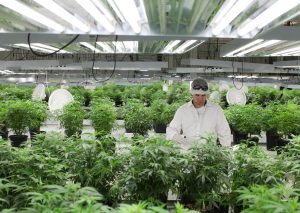Chapter 1: Perspectives on Human Resources Management: Exploring Why HRM Matters
Human Resource Management Day-to-Day

HRM and the birth of an industry: The birth of a marijuana producer
You have just been hired by High Growth Industries (HGI), a regionally accredited marijuana grower with headquarters in St Jerome. On your first day, you meet some of the employees and spend several hours with the company owner, Isidore Tremblay, hoping to get a handle on which human resource processes are already set up. HGI has established an excellent reputation as a tomato grower during more than 30 years of operation and has worked hard to achieve its motto of the “best tasting tomatoes in Quebec, all year long”. In 2015, HGI started a small operation of medical marijuana and with the recent legalization of marijuana in October 2018, it transformed all of its operations to marijuana culture. In 2019, it was awarded its largest contract ever from the Quebec Government that will make HGI one of the only five marijuana providers in the province. While the future of the industry is still not certain, it does show promise: the Canadian market is estimated to be between 5 and 10 billion dollars annually. HGI currently operates 3 greenhouses, which employ 55 employees, biologists, chemists, botanists, and manual workers. Here is one of the workers discussing her job.
A majority of the workers have been with HGI for more than 10 years. With the new government contract, the owner has very ambitious expansion plans. HGI will be adding between 50 and 100 technical employees in the next year, and a commensurate number of non-skilled staff. In the next five years, Mr. Tremblay wants to have 10 new greenhouses.
In the past, it was Mr. Tremblay and each greenhouse manager who performed all of the organization’s personnel functions…by the seat of their pants. Recruiting was done by word-of-mouth and performance appraisals rarely occurred. The company has been unionized for the better part of 20 years and the most recent contract expires January 1 of next year; the president was the chief union negotiator in prior negotiations. While these processes were sufficient for a tomato-growing company, it is another story for a company that operates in a tightly regulated industry such as marijuana production.
After your first day on the job, you realize it will be your responsibility to educate Mr. Tremblay on the value of a Human Resource Manager. You look at it as a personal challenge—both to educate him and also to show him the value of this role in the organization. First, you tell him that HRM is a strategic process having to do with the staffing, compensation, retention, training, and employment law and policies of the business. In other words, your job as the Human Resources (HR) Manager will be to not only write policy and procedures and to hire people (the administrative role) but also to use strategic plans to ensure the right people are hired and trained for the right job at the right time. For example, you ask him if he knows what the revenue will be in six months, and he answers, “Of course. We expect it to increase by 20 percent.” You ask, “Have you thought about how many people you will need due to this increase?” Mr. Tremblay looks a bit sheepish and says, “No, I guess I haven’t gotten that far.” You then ask him about the risk of being infiltrated by organized crime and the type of background checks that are being done when hiring new employees, as per the Cannabis Act (see below). He responds with….the sound of crickets.
He finally says “Well, it looks like we have some work to do. I didn’t know that human resources involved all of that.” You smile at him and start discussing some of the specifics of the business, so you can get started right away by writing the human resource management plan, starting with the need to be very careful with who you select.
Security clearances under the Cannabis Act and Regulations: Under the Cannabis Act and the Cannabis Regulations , key individuals associated with the holders of certain classes of licences must obtain a security clearance from Health Canada. Security clearances help minimize the risk to public health or public safety, including the risk of cannabis being diverted to an illicit market.

